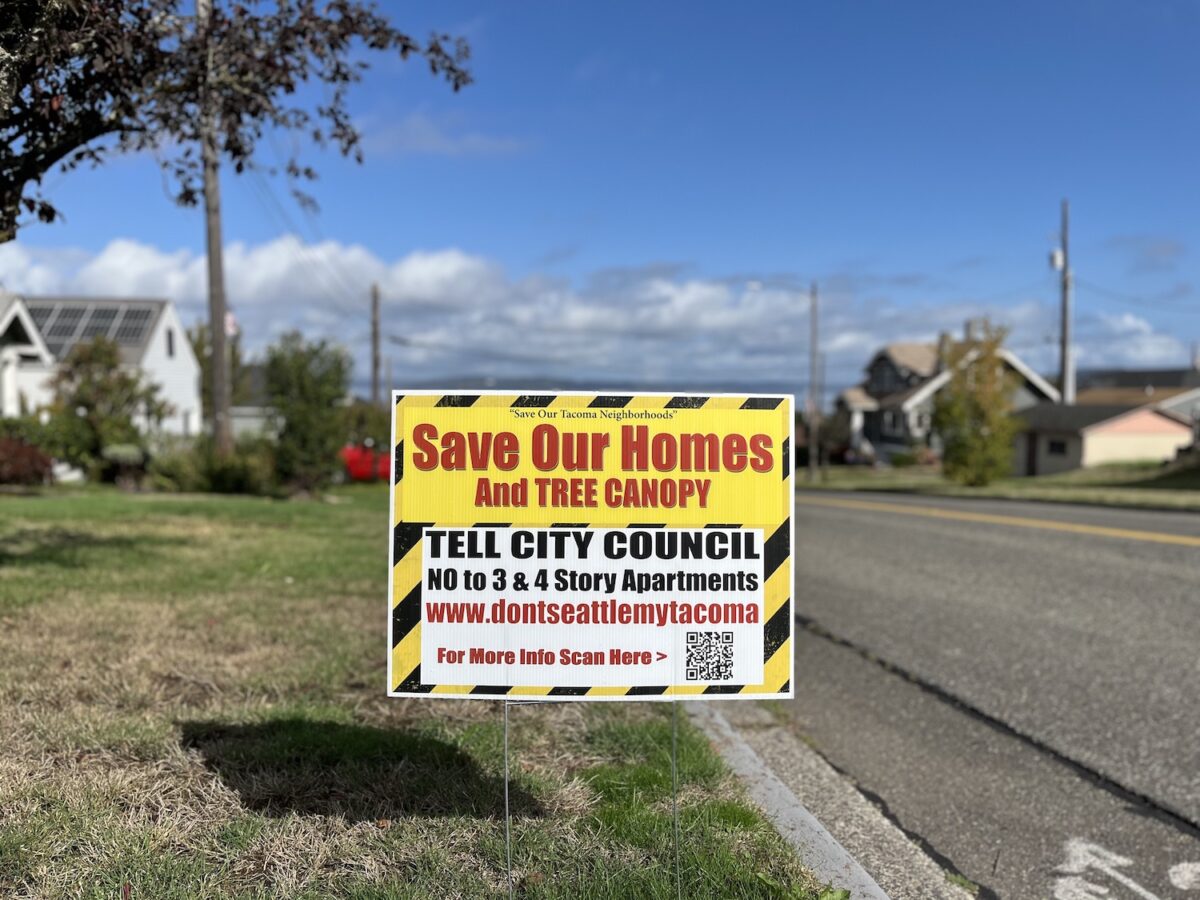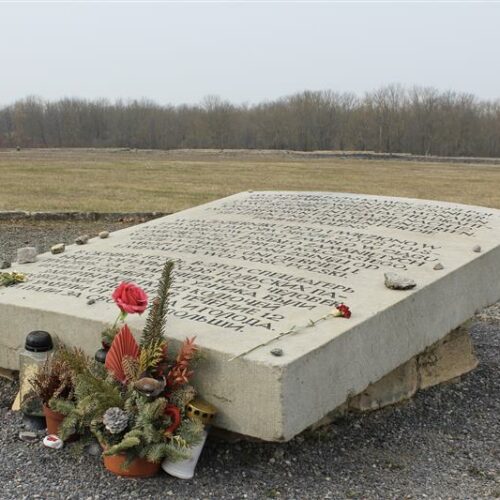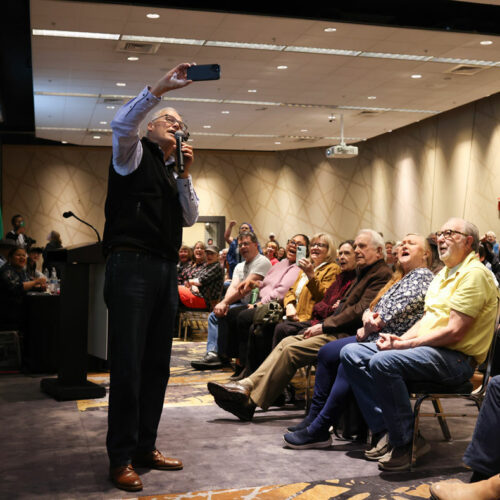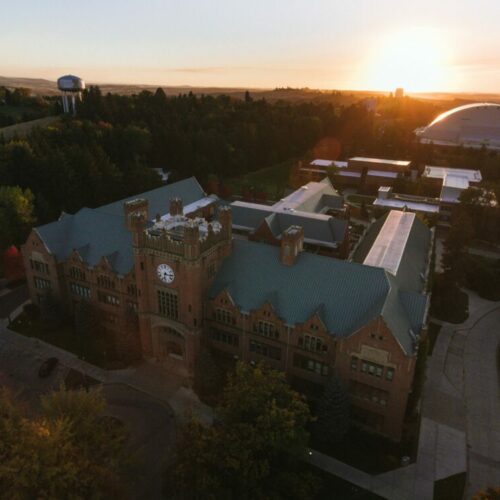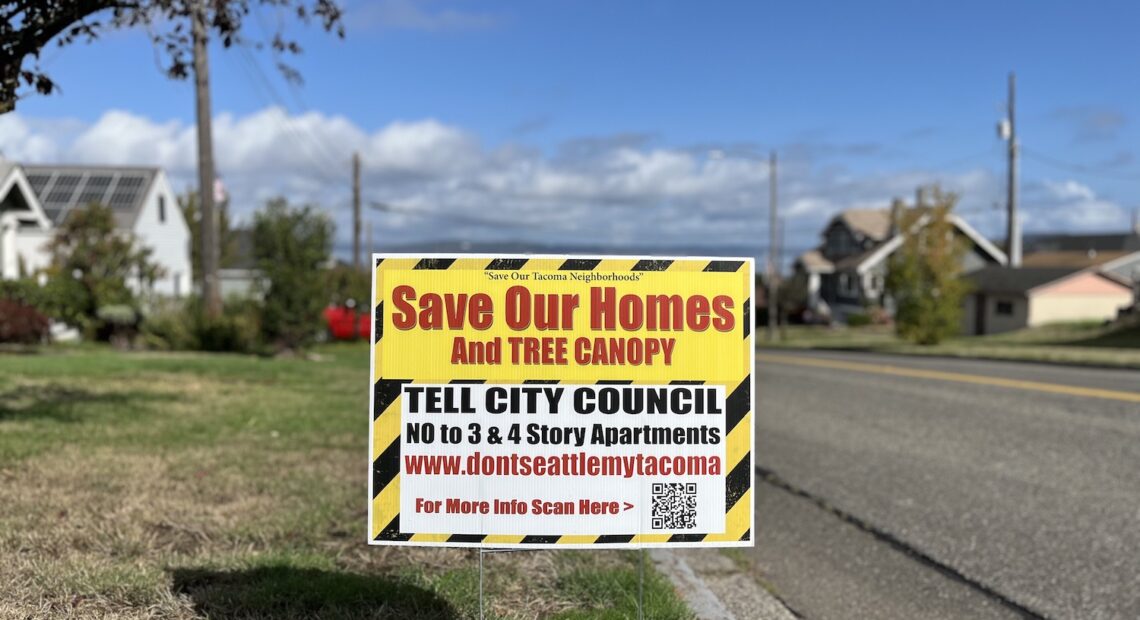
Next phase of housing, zoning changes being considered in Tacoma
Listen
(Runtime 1:07)
Read
In season four, episode 19 of the sitcom “Parks and Recreation,” actor Bradley Whitford plays a city council member in the fictional town of Pawnee, Indiana. Whitford tells Amy Poehler’s character, Leslie Knope, “City council isn’t about making everyone happy. In fact, every decision you make is going to make a lot of people very unhappy.”
Right now, the Tacoma City Council is considering a set of planning commission recommendations under the second phase of Home in Tacoma, the housing action strategy the city has been implementing over the last few years.
The response from residents has varied widely from people who are cautiously optimistic that the changes would be a good step forward to those who are asking the city to slow down and reconsider.
The package proposes, mainly, zoning changes for the residential areas of the city. The proposal would divide these areas into three different development categories that determine how many units a developer can build per lot. There would also be requirements for what is known as amenity space, which would include outdoor areas like yards and balconies. Developers would also have to meet a certain percentage of tree canopy.
While the proposals are for Tacoma, the changes also meet and exceed new state requirements that went into effect after the state Legislature passed HB 1110, known as the middle housing bill, which moves away from single-family zoning restrictions in Washington’s bigger cities.
What’s being proposed?
The package of changes presented by the planning commission includes zoning changes for residential development in the city. For years, the majority of Tacoma was reserved for single-family housing development, but the city, as well as the state, is moving away from that.
“Most places in the state are going through a very similar conversation to what Tacoma is, about how to adapt, how to allow for more housing units in our residential areas and how to make that fit as best as possible,” said Brian Boudet, the planning division manager for the city, during a Sept. 19 Q&A session for the public on the latest proposals.
There are three zoning classification structures being proposed. This map shows residents what zoning category their neighborhood would be in if the changes were adopted.
The number of how many structures that can be developed on a lot goes up with each zoning classification. There can be four units on an Urban Residential 1 lot, six units for an Urban Residential 2 lot and eight for an Urban Residential 3 lot. This is based on the concept of a 6,000 square foot lot, so if the lot size was bigger or smaller, that would change how many units are allowed. There are also height restrictions that vary based on the categories.
There are also ways more units could be developed within each urban residential area on one lot, including if a developer agrees to make a certain number of units affordable. That would be defined as renting for 80% of the area median income or less. Property owners can subdivide lots and put smaller homes on these separate parcels to rent or sell. This would apply to all three categories under the Home in Tacoma proposal.
“A lot of the proposal here is about allowing a greater diversity of housing throughout the city’s neighborhoods,” Boudet said.
How some Tacomans feel about the change
(Runtime 1:22)
State Sen. Yasmin Trudeau, who lives in and represents Tacoma, was the prime sponsor on the senate companion bill, SB 5190, to HB 1110 last year. She is one of the Tacomans who is supportive of what is being proposed in the second phase of Home in Tacoma, but feels it is just one piece of the puzzle to address housing issues in the city.
“I think that Home in Tacoma moves through a lot of real challenges, including the fact that Tacoma is a city that’s been really comfortable in some regards for a long time,” Trudeau said.
A lot of Tacomans showed up on Tuesday at City Hall to make their voice heard on what they want Tacoma’s neighborhoods to look — or at least — not look like.
The council chambers were packed that evening, with the back wall filled with attendees standing. When the clerk read how many written public comments had been submitted — 130 — the gathered crowd chuckled in camaraderie over their shared passion for the matter at hand.
What the crowd did not share were their opinions about the proposals.
Some residents say they’re in support of the city creating avenues for more housing development, but that they do not support the specifics being proposed. Some said that’s because they don’t think the proposals will serve those most in need of housing.
Heidi Stephens, who has served on the South End Neighborhood Council, spoke at Tuesday’s hearing.
“Home in Tacoma does nothing to guarantee truly affordable housing, the only people who believe that must be really out of touch. And how could it, when this is purely promoting for profit development, instead of working with existing bid units to bring costs down?” Stephens said.
Stephens and others shared their concern that the ability to develop more will result in a developer bidding war and price out current Tacomans.
The incentive for developers to create affordable units is that they can build more, but there is also the caveat that they can pay a fee in lieu of meeting that affordability requirement that goes to the city’s housing fund.
The planning commission’s feasibility analysis on the proposals showed duplexes and townhomes will be popular with the changes as those facilitate ownership for more people.
Some of Tacoma’s neighborhood councils, who have written letters to the city, expressed similar concerns on how added development won’t necessarily equal affordability.
In one such letter submitted by the North End Neighborhood Council, Peter Bennett, the council’s chair, quotes a minority report submitted by members of the planning commission in response to the initial Home in Tacoma proposal.
“… We will not see affordable development occur as a result of HIT. We will see more development in Tacoma, but it will be of the type that we have seen recently in the Proctor District — higher end developments with expensive rents,” Bennett quoted.
Others who support more housing have concerns with how much change would happen in their neighborhoods, or other concerns like a lack of parking requirements in certain residential areas in the city.
The proposal would effectively reduce parking requirements in residential areas to about half of what they are today, Boudet said in the Sept. 19 presentation.
Part of this is because the state said the city cannot require parking if the development is within half a mile of major transit facilities. Many supporters feel this would move the city forward toward more reliance on public transportation, but others criticized a lack of transit infrastructure to support this.
The North Slope Historic District shared a letter expressing concern that the proposal would result in the loss of historic homes and apartments, pointing out that much of their neighborhood was developed prior to land use zoning and contains mid-level housing.
A petition created by a group called Save Our Tacoma Neighborhoods has gathered over 700 signatures on a petition asking the city to not move forward with the proposal.
While not perfect, some said the proposals are a step in the right direction, including representatives from Habitat for Humanity, Downtown on the Go and Tacoma Urban Forest Friends, who all voiced their support of the proposals at Tuesday’s meeting.
The city council has study sessions scheduled over the next month. Then, the council is scheduled to vote on the proposal on Nov. 19.
If the city were to adopt the proposal then, developers would be able to begin applying for permits in February. Boudet said the planning committee is considering a pre-application testing period in December for people who want to see how the new requirements will work.

